| Title | Pages |
|---|---|
| Simultaneous Determination of Three Phenolic Compounds in Water Samples by Pre-column Derivatization Coupled with Reversed-Phase High Performance Liquid Chromatography In this study, a sensitive and accurate method for simultaneous separation and determination of three phenolic compounds (phenol, m-cresol and resorcinol) in water by revesed-phase high performance liquid chromatography using uv-visible detection has been described. Pre-column derivatization with 4-aminoantipyrine is used for the seperation and determination phenol, m-cresol and resorcinol in water. The derivatives formed within 5 min were extracted with chloroform and then analyzed by liquid chromatography with UV-visible detection at 440 nm. Chromatographic separation was performed using a reversed-phase column and acetonitrile-water (45:55%, v/v) as the mobile phase. The three derivatives were elueted in 13 min. The detection limits of phenol, m-cresol and resorcinol in a standard water sample were between 0.07 and 0.09μg.L-1 for 100 mL respectively. The recoveries of the derivatives from pure water were betweeen 97.1-102.3% within relative standard deviations of 2.3-4.7%. The method was applied to the analysis of phenols in different water samples. 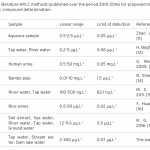 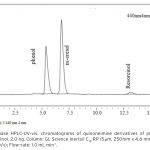 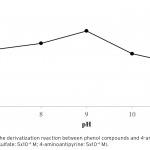 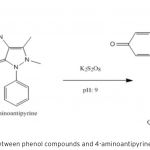 | 147 - 157 |
| Multilayer Graphene Oxide-Silver Nanoparticle Nanostructure as Efficient Peroxidase Mimic In this work, platinum (Pt), titanium (Ti) and silver (Ag) doped graphene oxide (GO) nanostructures were synthesized by using sonochemical technique, a relatively new technique in nanomaterial synthesis, and characterized in detail. The synthesized nanomaterials were characterized utilizing transmission electron microscopy (TEM) and X-ray photoelectron spectroscopy (XPS). TEM images and XPS spectras showed that the dopping process was successful. In addition, a multilayer graphene oxide-silver nanoparticles (M-GO- AgNPs) nano-structure was synthesized in this study for the first time, and it’s electrochemical performance was compared with GO-AgNPs. As a result of electrochemical study, the rate constants of the GO-AgNPs and M-GO-AgNPs modified electrodes were found as ksanodic = 6.62 s-1 and ksanodic = 6.78 s-1, respectively. Finally, the M-GO-AgNPs nano-structure obtained by sonochemical technique, a green chemistry synthesis technique, has been found to be suitable for use as an electrochemical sensor matrix. 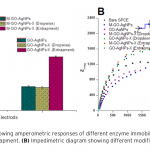 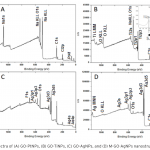 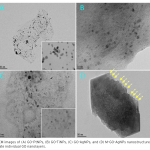 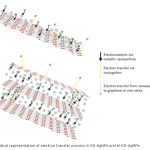 | 159 - 167 |
| Arylidene Carbazole Carbohydrazides: Synthesis and Characterization Because of the wide range of pharmacological activities and their distinctive structural features hydrazones and carbazole alkaloids have attracted considerable attention in medicinal chemistry. In this study, new carbazole acyl hydrozones (3a-k) which may have high biological activity potential, were synthesized with condensation reaction between carbazole hydrazide and benzaldehyde derivatives. After determination of the melting points of all synthesized derivatives, their structures were identified by FT-IR and 1H-NMR spectroscopic methods. 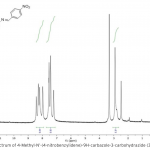 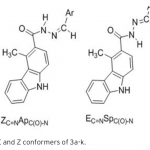 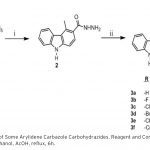 | 169 - 175 |
| A New Approach for Quorum Sensing System in Several Halophilic Bacteria Isolated from Salt Lake in Central Anatolia Quorum sensing (qs) is the system that microorganisms use to improve common behavior with another population member in their environment. Salt Lake in Turkey that is considered as an extreme environment due to its salt concentration, teems in plankton and bacteria. Especially, it is an important field for halophilic bacteria because it provides suitable growth conditions. In this study, it was determined that 20 halophilic bacteria strain isolated from Salt Lake could produce qs signal molecules which are N-acyl homoserine lactone (HSL) derivatives. For detection of these bacterial signal molecules, thin layer chromatography was utilized by using Chromobacterium violaceum cv026 and Agrobacterium tumefaciens A136 that are biosensor bacteria strains. Genomic analysis of strains that produce signal molecules was carried out via 16s rRNA. Halobacterium salinarium, Salicola sp., Halovibrio, and Halomonas were found to be common in Salt Lake. It was also observed that these strains could produce C6-HSL and C8-HSL signaling molecules and produce biofilms. 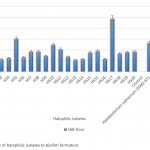 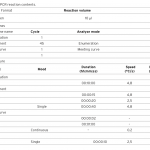 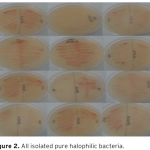 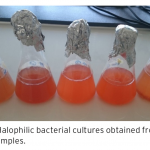 | 177 - 185 |
| Selective Separation and Preconcentration of Thorium(IV) in Bastnaesite Ore Using Thorium(IV)-Imprinted Cryogel Polymer In this study, selective separation and preconcentration of Th(IV) in aqueous solutions and bastnaesite ore in the presence various lanthanide ions by using Th(IV)-imprinted polymer was conducted. For this purpo- se, Th(IV) was complexed with N-methacryloyl antipyrine (MAAP) and the prepared (MAAP)2-Th(IV) complex monomer was polymerized with 2-hydroxyethyl methacrylate (HEMA) cryogel to prepare pHEMA-(MAAP)2-Th(IV) cryogel polymer by free radical polymerization. Th(IV) was desorbed with 5.0 mol.L-1 HNO3 and thus Th(IV)-imrinted were created onto p-HEMA-(MAAP)2 cryogel polymer. To determine the optimum conditions, in the process of selective binding of Th(IV) ion to Th(IV)-imprinted p-HEMA-(MAAP)2 cryogel polymer, some parameters such as pH, flow rate, initial Th(IV) concentration were investigated. Under the optimum conditions, the maximum binding capacity was obtained as 48.30 mg.g-1. Selectivity studies were also carried out in the presence of Ce(III), La(III) and Eu(III) ions using Th(IV)-imprinted p-HEMA-(MAAP)2 cryogel polymer. It was found that p-HEMA-(MAAP)2 cryogel polymer displayed high selectivity toward Th(IV) ion. 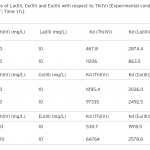 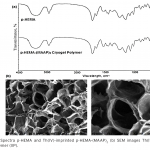 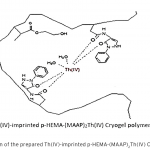 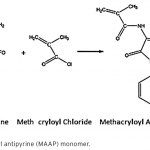 | 187 - 197 |
| Petaloid Monocotyledonous Flora of Tunceli Province (Turkey) This study was carried out to determine the monocotyl petaloids of Tunceli Province (Turkey). The research area is located in B7 square and a little part in B8 square based on the quadratic system of Davis. In this rese- arch, the field studies were carried out in Tunceli during 2014-2015. Totally 150 taxa (142 species, 4 subspecies and 4 varieties) which are 33 endemic were identified belonging to 11 families. Of the taxa found in the area, 26 were newly recorded for the province of Tunceli. This study is part of the ongoing research to determine for Flora of Tunceli. 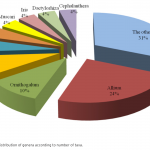 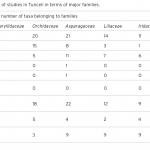 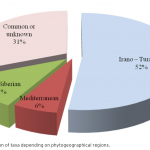  | 199 - 219 |
| Economically Productive Features of Turkeys Breed in Azerbaijan Turkey breeding is an important source of increased production of high-quality bird meat. Many years of experience shows the effectiveness of industrial turkey breeding. Among the meat species of poultry, the turkey occupies a special place. By its biological and economic characteristics, it is one of the most promising species of meat poultry. Turkeys have a high fertility and high yield of edible parts per unit of live weight. The aim of the research was creating new highly productive breeds, lines and to study the dynamics of the economic-useful qualities of turkeys of various lines, breeds and productive, interior features, quality of meat of turkeys breed in the conditions of Azerbaijan. 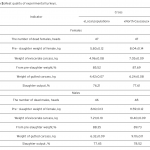 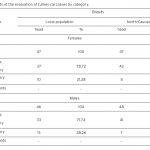 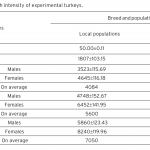 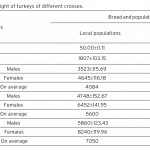 | 221 - 227 |
| Detection of Lipase Production from Newly Isolated Trichoderma Citrinoviride The production of lipase is aimed from a new fungal source in this study. Fungus was isolated from soil locality Kocaeli. It was determined as Trichoderma citrinoviride by the analysis of 18S rRNA sequence. Various parameters and media components were investigated for production of lipase. Glucose and peptone were found to be most suitable carbon and nitrogen source, respectively. To determine the suitable oil as carbon source, various oils were added to the production medium. Olive oil was found to be the optimal oil for lipase production from Trichoderma citrinoviride. pH 5.5, temperature 30°C and incubation time for 4 days were found to be optimal incubation conditions for lipase production. We also determined lipase yield fromTrichoderma citrinoviride which is produced in molasses medium as an alternative carbon source. 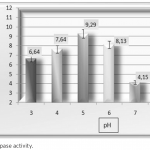 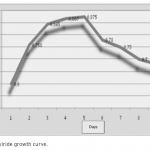 | 229 - 235 |
| Cytotoxic Effects of Thiazolo[3,2-C]Pyrimidines Against Mcf-7 And Hepg2/C3a Carcinoma Cell Lines In the present study, a series of thiazolo[3,2-c]pyrimidines (4,5) have been produced via simple and efficient synthetic method and their in vitro cytotoxicities have been performed on human breast (MCF-7) and hepatocellular (HEPG2/C3A) adenocarcinoma cell lines. The results of these in vitro tests revealed that at least five of thiazolo[3,2-c]pyrimidines exhibited strong cytotoxic effects at very low concentrations, which were very similar or lower than that of reference anticancer agent, 5-FU, against MCF-7 and HEPG2/C3A cancer cell lines. 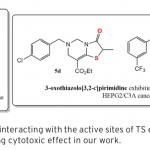 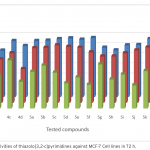 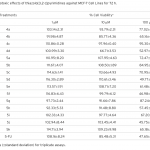 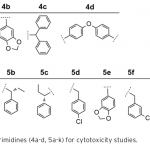 | 237 - 246 |
| Characterization of Local Trichoderma spp. as Potential Bio-Control Agents, Screening of in vitro Antagonistic Activities and Fungicide Tolerance Enlightening effects of biocontrol agents as Trichoderma spp. to provide disease control by combating pat- hogens is an important alternative in agricultural crop production. To that end, 9 species of Hypocrea/ Trichoderma having green ascospores isolated from the soil that tea plants cultivated in are identified by ITS sequences and were found to be close relative of Trichoderma sect. Pachybasium (77%). Ethyl acetate extracts of fungal isolates exhibited the antimicrobial activity against to Vibrio sp, Serratia marcescens, Mycobacterium smegmatis and Bacillus cereus but no antifungal activity was detected. The highest level of inhibitory activity was observed against to M. smegmatis by Trichoderma harzianum ID4A, ID4B and ID6B. In dual culture test, allTrichoderma strains were found to be showing the highest inhibitory activity against to the plant pathogensBotrytis cinerea, Sclerotonia sclerotiorum and Rhizoctonia solani (AG3), but relatively low activity against to the entomopathogen fungi. Volatile metabolites of Trichoderma spp. caused maximum reduction in mycelial growth and sclerotial production. Tested strains showed the highest tolerance to the fungicide Dikozin, where- as the lowest tolerance was against to the Captan regardless of the dosage. 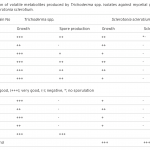 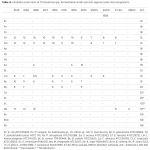 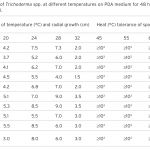 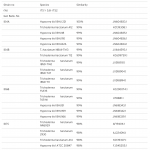 | 247 - 261 |
| The Effect of Trichoderma Seed Priming to Drought Resistance in Tomato (Solanum lycopersicum L.) Plants Tomato is one of the most important food crops immensely affected by water scarcity. Therefore, it is vital to find biocontrol agents for improving the yield of tomato crop in arid areas. The fungal genus, Trichodermais widely used as an eco-friendly, biocontrol agent in commercial formulas because of the various beneficial effects it has on plants including the resistance to biotic and abiotic stresses. In the present study, the ef- fects of an isolate of Trichoderma atroviride ID20G (Ta) on tomato (Solanum lycopersicum L.) seedlings were investigated under drought stress. The isolated fungus was identified using ITS (internal transcribed spacer) sequences. Root colonization by Ta induced changes in growth performance indexes such as root growth, root branching, and leaf number as compared to the untreated seedlings. Chlorophyll and carotenoid contents of the untreated tomato seedlings decreased after drought stress along with extensive membrane deterioration, whereas seed colonization by Ta prevented lipid oxidation and ameliorated the harmful effects of drought on pigment contents. Antioxidant enzyme activity was elevated and hydrogen peroxide (H2O2) concentration was found to decrease under drought stress in the Ta treated seedlings. These observations suggest that coloniza- tion of tomato seedlings by Ta is effective in counteracting the injurious effects of drought, and therefore, may have a prominent role in increasing the drought tolerance of tomato plant by decreasing H2O2 concentration and activating the antioxidant enzymes. Furthermore, fungus-based biocontrol agent formulation of Ta might serve as a potential tool in tomato agriculture owing to its low cost, effectiveness, and characteristics required for balancing the natural ecology. 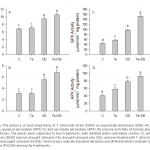 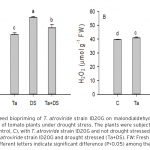 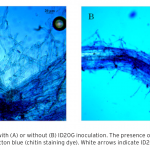 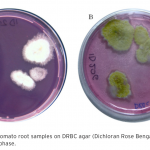 | 263 - 272 |
| Development of MIP-based QCM Sensors for Determination of Hyaluronic Acid (HA) In this study, quartz crystal microbalance (QCM) based recognition systems have been developed for the determination of hyaluronic acid (HA). For this purpose, firstly; N-methacryloyl-l-tyrosine (MAT), MAT-D- Glucuronic acid (MAT-D-GA) and MAT-Cu(II)-D-Glucuronic acid (MAT-Cu(II)-D-GA) pre-organized monomers have been synthesized, and characterized. Then, D-glucuronic acid active sites of HA biomacromolecule have been imprinted on QCM sensor surface to create HA selective binding sites. In the last step, the binding interactions, usabilities in recognition and determination of prepared sensors have been investigated. 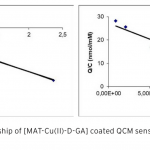 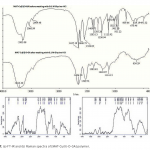 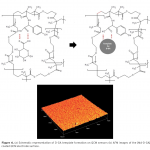 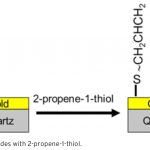 | 273 - 283 |
| Cholesterol Adsorption from Artificial Human Plasma with Molecular Imprinted Polymeric Nanostructures This study reports cholesterol adsorption from artificial human plasma using MIP nanostructures prepared with different template:monomer ratios. The adsorption capacity of CP is 19.9% and 16.1% higher than those of C3P and CP3, respectively and adsorption capacity of CP is significantly higher than NIP nanostructures. All selectivity coefficients and relative selectivity values were higher than 1 for artificial human plasma. Under optimum conditions, considerably high cholesterol was adsorbed from hypercholesterolemic plasma (95.33 %). 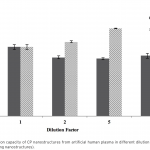 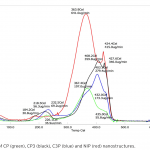 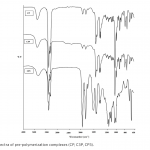 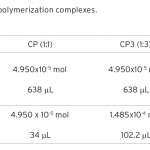 | 285 - 296 |
| The Effects of Juvenile Hormone Analogue, Fenoxycarb on the Last Instar Testes of Bombyx mori The development and metamorphosis of insects is regulated by juvenile hormone (JH) and ecdysone hormone, which are worked antagonist. Fenoxycarb is an effective juvenile hormone analogue on many insects. In this study, the effect of fenoxycarb on the last larval stage Bombyx mori testes was investigated. Male larvae on the 6th day of the last instar are divided into 2 groups. 1 ng of fenoxycarb dissolved in acetone was topically applied to larvae in the treatment group and the remaining 18 larvae were used as the control group. Control and treated groups were followed to until pupation from day when they showed cocoon spinning behavior. After dissection, several of testes were entreated routine histological processes and photographed. In treatment group, it was seen that fenoxycarb reduced spermatogonium formation by suppressing ecdysone release and caused a decrease in mature sperm. Remaining testes are used to the analysis of total carbohydrate and glycogen content. In conclusion, fenoxycarb has the reducing effect on spermatogenesis and it can cause to decrease of total carbohydrate content because of stress in insects. These histological and biochemical results may be in support of the use of fenoxycarb as an insect growth regulator (IGR) for harmful insects. 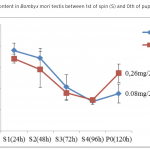 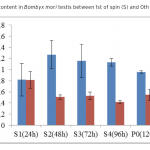 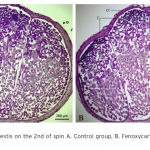 | 297 - 305 |
| A Bacterial Machinery for Surface Displayed Enzymes Biomaterial based protein delivery systems have been utilized for many applications in biomedicine. Despite their great success, there is a need to develop innovative living, decision making systems for protein delivery. In this context, here, a cellular system is proposed for protein release and delivery. Such systems can be used not for biomedical purposes but also for other biochemical applications. In this regard a Escherichia coli autotransporter protein, Ag43 was engineered to display on its cell membrane. Using this system alkaline phosphatase protein is displayed on the cell surface as a fusion of Ag43-ALP which is also carrying a specific TEV protease excision site. It was shown that the active from of the enzyme was released upon its interaction with TEV protease from the cell surface. In this study a cellular machinery is proposed to be used as a controlled enzyme delivery system. 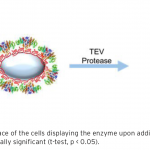 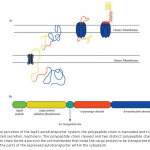 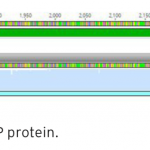 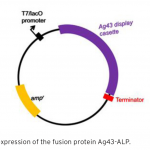 | 307 - 313 |